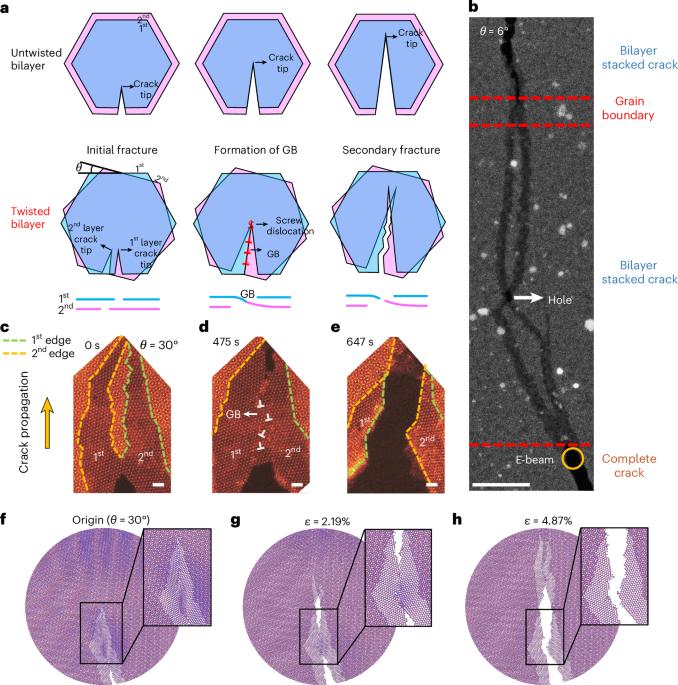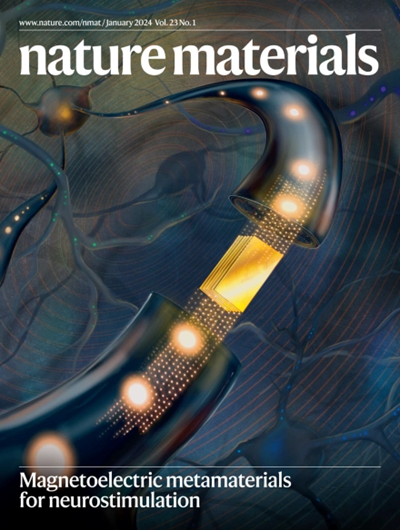扭转辅助二维过渡金属二硫族化合物的本征增韧
IF 38.5
1区 材料科学
Q1 CHEMISTRY, PHYSICAL
引用次数: 0
摘要
材料断裂通常是不可逆的,标志着一次性事件导致失败。为了提高工程应用的大块材料的强度和断裂韧性,人们做出了巨大的努力,例如引入自恢复和二次断裂行为。在低维结构中,二维材料通常表现出特殊的强度,但伴随着极端的脆性。在这里,我们发现二维材料的韧性可以在不牺牲强度的情况下得到增强——只需简单地扭转层。通过原位扫描透射电子显微镜,在纳米压痕和理论分析的支持下,我们发现扭曲的双层结构使连续断裂事件发生:初始裂纹愈合形成稳定的晶界,然后保护随后的断裂尖端免受应力集中的影响。与常规断裂相比,该过程消耗额外的能量,并且可以通过调整扭角来增强韧性。通过扭转的固有增韧机制,以及目前吸引了大量关注的扭曲电子学的新兴电子特性,为未来的设备提供了令人兴奋的机会。本文章由计算机程序翻译,如有差异,请以英文原文为准。


Twist-assisted intrinsic toughening in two-dimensional transition metal dichalcogenides
Material fractures are typically irreversible, marking a one-time event leading to failure. Great efforts have been made to enhance both strength and fracture toughness of bulk materials for engineering applications, such as by introducing self-recovery and secondary breaking behaviours. In low-dimensional structures, two-dimensional materials often exhibit exceptional strength but accompanied by extreme brittleness. Here we discover that the toughness of two-dimensional materials can be enhanced without sacrificing strength—by simply twisting the layers. Through in situ scanning transmission electron microscopy, supported by nanoindentation and theoretical analysis, we reveal that twisted bilayer structures enable sequential fracture events: initial cracks heal to form stable grain boundaries, which then shield subsequent fracture tips from stress concentration. This process consumes additional energy compared with conventional fracture, with toughness enhancement tunable through twist angle adjustment. The intrinsic toughening mechanism via twisting, along with the emerging electronic properties of twistronics that are currently attracting substantial attention, presents an exciting opportunity for future devices. Intrinsic toughening in two-dimensional transition metal dichalcogenides can be achieved simply by twisting the layers. This twisting promotes cross-layer healing and grain boundary formation, which shield fracture tips from stress concentration.
求助全文
通过发布文献求助,成功后即可免费获取论文全文。
去求助
来源期刊

Nature Materials
工程技术-材料科学:综合
CiteScore
62.20
自引率
0.70%
发文量
221
审稿时长
3.2 months
期刊介绍:
Nature Materials is a monthly multi-disciplinary journal aimed at bringing together cutting-edge research across the entire spectrum of materials science and engineering. It covers all applied and fundamental aspects of the synthesis/processing, structure/composition, properties, and performance of materials. The journal recognizes that materials research has an increasing impact on classical disciplines such as physics, chemistry, and biology.
Additionally, Nature Materials provides a forum for the development of a common identity among materials scientists and encourages interdisciplinary collaboration. It takes an integrated and balanced approach to all areas of materials research, fostering the exchange of ideas between scientists involved in different disciplines.
Nature Materials is an invaluable resource for scientists in academia and industry who are active in discovering and developing materials and materials-related concepts. It offers engaging and informative papers of exceptional significance and quality, with the aim of influencing the development of society in the future.
 求助内容:
求助内容: 应助结果提醒方式:
应助结果提醒方式:


